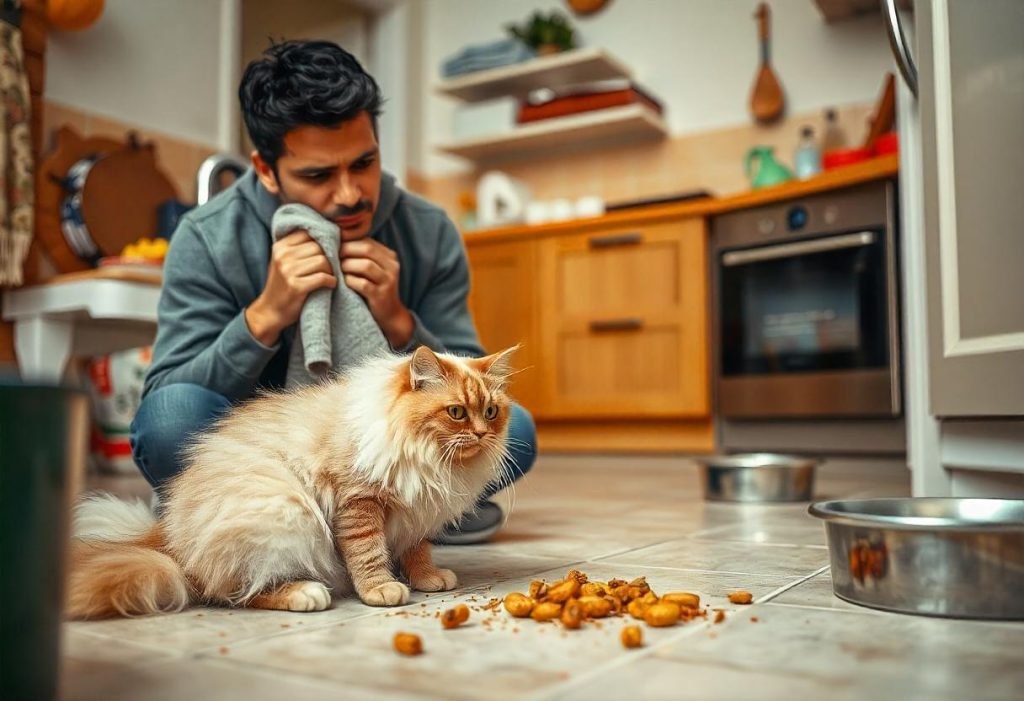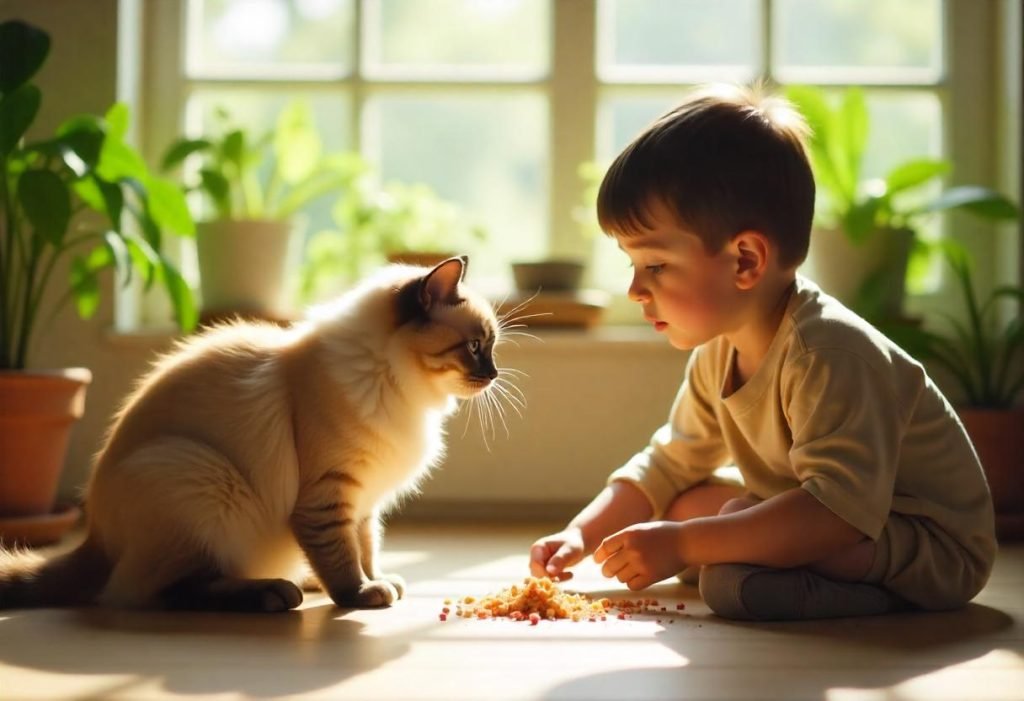Seeing your cat heave up a mouthful of undigested food can be unsettling. Cat owner could be very worried that why is my cat throwing up undigested food.
It’s like a window into their digestive system, revealing a process gone awry. While the sight of a few undigested kibbles might not be alarming, it’s a different story when this becomes a recurring event, especially if accompanied by other symptoms.
This article dives into the world of feline regurgitation, exploring the diverse range of causes behind undigested food vomit, offering insights into potential complications, and guiding you towards effective solutions.
We’ll break down complex medical jargon into easy-to-understand language, using real-life case studies to illustrate the journey towards a happy, healthy, and vomit-free kitty.
Understanding Feline Regurgitation: A Deeper Dive
Imagine a sudden expulsion of stomach contents, often appearing as if the food hasn’t even been processed.
This is the experience your cat might be having when they regurgitate. Regurgitation is different from vomiting, where food is actively pushed out of the stomach with force.
With regurgitation, the food tends to come up more passively, often appearing as if it’s been brought up “whole.”
1. Hairballs: A Common Culprit
Cats are meticulous groomers, and during this process, they often ingest loose hair. This hair can accumulate in their stomach and form hairballs.
When these hairballs become too large, they can obstruct the passage of food, causing regurgitation of undigested food.
- Symptoms: Regurgitation, often with a hairball-like mass, often appearing after eating or grooming.
- Diagnosis: Based on the appearance of the vomit, which usually contains hair.
- Treatment: Regular brushing to minimize hair ingestion, hairball remedies, and sometimes dietary changes can help prevent hairballs.
Case Study: Charlie’s Hairball Regurgitation
Charlie, a 4-year-old tabby, was known for his meticulous grooming habits. He frequently regurgitated hairballs, often with undigested food, after grooming sessions.
His owner started brushing him more frequently, and Charlie’s regurgitation episodes decreased.
2. Gastroesophageal Reflux Disease (GERD): A Backflow Problem
GERD occurs when stomach acid or food backs up into the esophagus, often due to weakened muscles or a malfunctioning valve at the junction of the esophagus and stomach.
- Symptoms: Regurgitation, often of undigested food, particularly after eating, sometimes with a sour odor.
- Diagnosis: Based on clinical signs and possibly endoscopy to examine the esophagus and stomach.
- Treatment: Dietary changes, medication to neutralize stomach acid or strengthen esophageal muscles, and lifestyle modifications can help manage GERD.
Case Study: Lily’s Frequent Regurgitation
Lily, a 7-year-old Persian, was frequently regurgitating undigested food, often shortly after eating.
Her veterinarian suspected GERD and recommended a special diet and medication to strengthen her esophageal muscles. With these measures, Lily’s regurgitation episodes decreased.

3. Esophageal Obstruction: Blockages in the Food Pathway
Objects like hairballs, food, or even foreign objects can become lodged in the esophagus, blocking the passage of food.
- Symptoms: Regurgitation, sometimes with a foreign object visible in the vomit, difficulty swallowing, drooling, and possibly coughing.
- Diagnosis: Based on clinical signs and often confirmed with radiographs (X-rays) or endoscopy.
- Treatment: Removal of the obstruction, often through endoscopy or surgery.
Case Study: Max’s Esophageal Obstruction
Max, a 9-year-old Siamese, was regurgitating undigested food and seemed to have difficulty swallowing.
His veterinarian suspected an esophageal obstruction and performed an endoscopy, revealing a large hairball. The hairball was removed, and Max’s symptoms resolved.
4. Food Allergies: Dietary Sensitivities
Food allergies, a common problem in cats, can trigger a range of digestive issues, including regurgitation.
- Symptoms: Regurgitation, vomiting, diarrhea, itchy skin, and possibly hair loss.
- Diagnosis: Based on clinical signs and possibly food elimination trials or allergy testing.
- Treatment: Switching to a hypoallergenic diet or eliminating the offending ingredient can help resolve symptoms.
Case Study: Oliver’s Food Allergy
Oliver, a 12-year-old tabby, was regurgitating undigested food, often with a sour odor, and seemed to have itchy skin.
His veterinarian suspected a food allergy and recommended a hypoallergenic diet. After changing his diet, Oliver’s regurgitation and skin issues subsided.
5. Inflammatory Bowel Disease (IBD): Inflammation of the Digestive Tract
IBD, a chronic condition that causes inflammation in the gastrointestinal tract, can impact digestion and lead to regurgitation of undigested food.
- Symptoms: Regurgitation, vomiting, diarrhea, loss of appetite, and weight loss.
- Causes: The exact cause of IBD is unknown, but it might be related to immune system dysfunction, allergies, or infections.
- Diagnosis: Based on clinical signs, endoscopy, and possibly biopsies of the intestinal lining.
- Treatment: Dietary changes, medication to manage inflammation, and sometimes probiotics can help manage IBD.
Case Study: Bella’s IBD Diagnosis
Bella, an 8-year-old Siamese, was regurgitating undigested food, had diarrhea, and seemed to have lost weight.
Her veterinarian diagnosed IBD and recommended a special diet and medication to manage inflammation. After treatment, Bella’s symptoms improved.

6. Pancreatitis: Inflammation of the Pancreas
Pancreatitis, an inflammation of the pancreas, can disrupt digestion and lead to regurgitation, sometimes with undigested food.
- Symptoms: Regurgitation, vomiting, abdominal pain, loss of appetite, and lethargy.
- Causes: High-fat meals, certain medications, and underlying conditions can trigger pancreatitis.
- Diagnosis: Blood tests, imaging studies, and sometimes biopsies can help diagnose pancreatitis.
- Treatment: Pain medication, fluid therapy, and nutritional support can help manage pancreatitis.
Case Study: Charlie’s Pancreatitis
Charlie, a 6-year-old tabby, was regurgitating undigested food, had abdominal pain, and seemed lethargic.
His veterinarian diagnosed pancreatitis and prescribed pain medication and fluid therapy. After several days of treatment, Charlie’s condition improved.
7. Megaesophagus: A Dilated Esophagus
Megaesophagus, a condition where the esophagus becomes abnormally dilated, can cause regurgitation of undigested food as the esophagus cannot effectively transport food to the stomach.
- Symptoms: Regurgitation, often with a large volume of undigested food, difficulty swallowing, coughing, and possibly choking.
- Causes: The exact cause of megaesophagus is often unknown, but it might be associated with genetic factors, neurological disorders, or other underlying conditions.
- Diagnosis: Radiographs (X-rays) or endoscopy can help diagnose megaesophagus.
- Treatment: Dietary changes, postural feeding techniques, and sometimes medication can help manage megaesophagus.
Case Study: Lily’s Megaesophagus Diagnosis
Lily, a 4-year-old Persian, was regurgitating large amounts of undigested food, often with a choking sound.
Her veterinarian diagnosed megaesophagus and recommended postural feeding techniques to help her swallow food more effectively.
8. Tumors: A Potential Cause of Digestive Issues
Tumors, both benign and malignant, can develop in the digestive tract, obstructing the passage of food and leading to regurgitation.
- Symptoms: Regurgitation, vomiting, difficulty swallowing, loss of appetite, and weight loss.
- Causes: Tumors can arise from different tissues within the digestive system.
- Diagnosis: Endoscopy, biopsy, and imaging studies, such as CT scans, can help diagnose tumors.
- Treatment: Surgery to remove the tumor, radiation therapy, or chemotherapy, depending on the type and location of the tumor.
Case Study: Max’s Esophageal Tumor
Max, a 9-year-old Siamese, was regurgitating undigested food, had difficulty swallowing, and seemed to have lost weight.
His veterinarian diagnosed an esophageal tumor and recommended surgery to remove it. After the surgery, Max’s symptoms improved significantly.
Decoding Your Cat’s Undigested Vomit: Seeking the Source
When you notice your cat regurgitating undigested food, it’s essential to determine the underlying cause to provide appropriate treatment.
Here’s how to approach the situation:
1. Observation: The Power of Careful Watching
- Regurgitation frequency: Keep a log of your cat’s regurgitation, noting how often they regurgitate, the appearance of the vomit (color, consistency), and any other symptoms.
- Other symptoms: Observe your cat for any other symptoms, such as lethargy, loss of appetite, diarrhea, difficulty swallowing, coughing, or weight loss.
- Environmental factors: Consider any recent changes in your cat’s environment that could be causing stress or anxiety.
2. Veterinary Examination: Seeking Professional Guidance
- Physical examination: Your veterinarian will conduct a thorough physical exam, checking for any signs of illness or injury.
- Diagnostic tests: Depending on the suspected cause, your veterinarian may recommend bloodwork, fecal exams, urinalysis, radiographs (X-rays), endoscopy, or other diagnostic tests.
Treating Regurgitation in Cats: A Tailored Approach
Treating regurgitation in cats depends on the underlying cause, and your veterinarian will create a personalized treatment plan.
- Dietary changes: Switching to a bland diet, a prescription diet, or a diet tailored to your cat’s needs can help manage symptoms.
- Hairball remedies: Hairball remedies can help lubricate the digestive tract and prevent hairballs.
- Medication: Anti-emetics, proton pump inhibitors, or other medications might be prescribed to reduce regurgitation and manage underlying conditions.
- Surgery: In cases of obstructions or tumors, surgery might be necessary to address the underlying issue.
- Postural feeding techniques: For megaesophagus, feeding your cat in an upright position can help prevent regurgitation.
Preventing Regurgitation in Cats: A Proactive Approach
While some factors contributing to regurgitation are unavoidable, you can take proactive steps to support your cat’s digestive health and prevent these issues.
- Regular veterinary checkups: Yearly checkups can help identify early signs of illness and prevent complications.
- Dietary considerations: Provide a high-quality, nutritionally balanced diet that meets your cat’s specific needs.
- Hairball prevention: Regular brushing and hairball remedies can help minimize hair ingestion.
- Stress management: Create a calm and comfortable environment for your cat, minimizing disruptions and providing enrichment activities.
Conclusion: A Journey Towards a Healthy, Vomit-Free Cat
Seeing your cat regurgitate undigested food can be a sign of something more serious. Understanding the potential causes behind this regurgitation is crucial for effective treatment.
By observing your cat carefully, seeking professional help, and implementing appropriate management strategies, you can help your furry friend enjoy a healthy, comfortable, and vomit-free lifestyle.
Note: This article is for informational purposes only and should not be substituted for professional veterinary advice. Always consult with your veterinarian for a proper diagnosis and treatment plan for your cat’s specific needs.

Leave a Reply